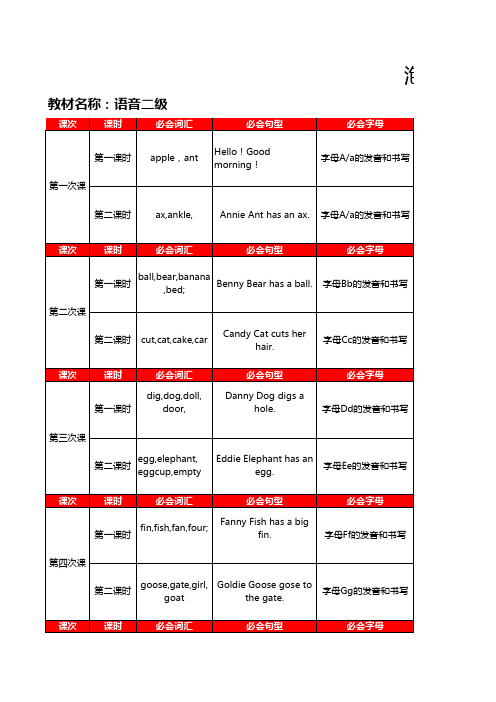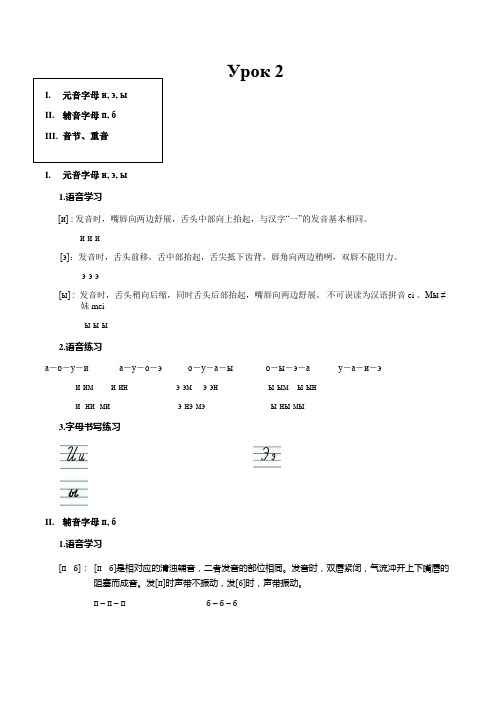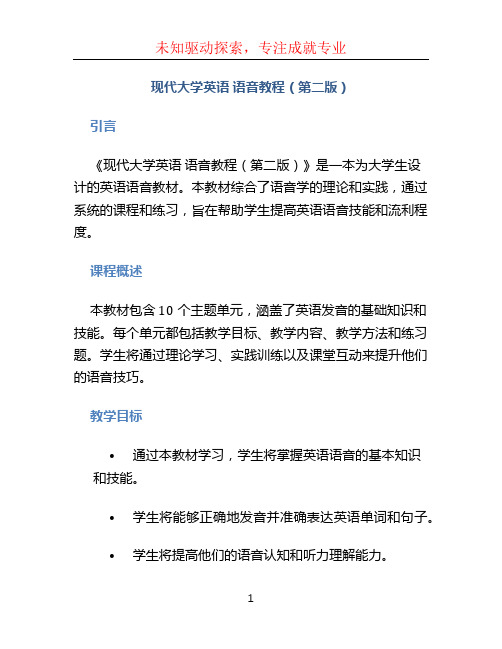语音第2课
【语音专项】Lesson 2 自然拼读课件 元音的两种发音(全国通用版)

D.mother
Lesson 2 元音字母的发音
第01课 自然拼读启蒙 元音
第02课 1. 闭短 第04课 2. 开长 第06课 3.先入为主 第08课 4.R音组
第03课 第05课 第07课 第09课
第10课 第12课 第14课
5.O音组
第11课
6.懒元音
第13课
国际音标+多音节单词划分
第15课 阅读视觉词+句子发音技巧
kite home cute
闭音节中元音的发音
闭音节
a
/æ/ bag 大嘴音
e
i
o
/e/
/i/
/ɒ/
bed
pig
top
微笑音 报数音 打鸣音
短元音发音看长相
u
/ʌ/ hug 尖叫音
开音节中元音字母的发音
a
e
/ei/
/i:/
开音节 game Pete
iou
/ai/
/əʊ/
/ju:/
kite home cute
sun lunch bus duck hug
un
ug
总结: u /ʌ/ 尖叫音
bug cup dub fug gum hub jug lum mud nun pug rum sub wud yum yup
总结
U在u-e结尾的单词中读字母音:/ju:/ u /ju:/ 辅音+元音 u +辅音 +e
Exercise 2
ice-cream冰激凌 pipe管子 time时间 rice米粉
bike自行车
wine葡萄酒 bite咬; five五
nine九
kite风筝
少儿语音二级教学大纲

Henn Hen has a hat./h//h//h/;Henn Hen 区分hen母鸡&chicken鸡肉;鸡 has a hat./h//h//h/;/h/ 2A课本第17页活动1,活动2 is the sound of H.
;Ian Insect is ill in bed./i//i//i/;Ian Insect 英文字母I表示第一人称单数我 is ill in bed./i//i//i/;/i/is the 2A课本第19页活动1,活动2 sound of H. 必会歌曲 本课时文化常识 本课时建议作业
必会歌曲
本课时文化常识
本课时建议作业
ny Goat has a wet nose./n//n//n/;Nanny Goat N表示北方,S表示南方 has a wet nose./n//n//n/;/n/is 2B课本第3页活动1,活动2 the sound of N.
第一课时 ball,bear,banana,bed; Benny Bear has a ball. 第二次课 第二课时 课次 课时 第一课时 第三次课
cut,cat,cake,car Candy Cat cuts her hair. 字母Cc的发音和书写 必会词汇 dig,dog,doll, door, 必会句型 Danny Dog digs a hole. 必会字母 字母Dd的发音和书写
enie Quail is quiet./kw//kw//kw/;QueenieQ表示queen女王,王后 Quail is quiet./kw//kw//kw/;/kw/is 2B课本第9页活动1,活动2 the sound of Q. 必会歌曲 本课时文化常识 本课时建议作业
cky Rabbit reads a book./r//r//r/;Ricky Rabbit reads a book./r//r//r/;/r/is 2B课本第11页活动1,活动2 the sound of R.
(最新整理)汉语口语速成入门篇第2课

2021/7/26
44
生词 New Words
➢ 书(名noun )shū book ➢ 笔(名noun )bǐ pen ➢ 书包(名noun )shūbāo schoolbag
➢ 专名 (Proper names) ➢ 可口可乐 kěkǒu kělè Coca-cola
2021/7/26
45
课文 Text
2021/7/26
31
New words 生词
忙 máng busy (形adj.)
2021/7/26
32
New words 生词
累 lèi Tired (形adj.)
2021/7/26
33
New words 生词
饿 è
hungry
(形adj.)
2021/7/26
34
New words 生词
d dai dei dao dou dan
dang deng dong
t tai
tao tou tan
tang teng tong
n nai nei nao
nan nen nang neng nong
l lai lei lao lou lan
lang leng long
2021/7/26
22
拼音 Spelling
New words 生词
māmɑ 妈妈
bàbɑ 爸爸
ɡēɡe 哥哥
2021/7/26
29
New words 生词
nǎinɑi 奶奶
yéye 爷爷
mèimei
jiějie
妹 妹 2021/7/26
姐姐
30
New words 生词
➢ 他们(代pronoun) tāmen they; them ➢ 他(代pronoun) tā he; him ➢ 她(代pronoun) tā she; her ➢ 爱人(名noun) àiren husband or wife ➢ 我 (代pronoun) wǒ I
语音课教学ppt课件

选择适合学生水平的朗读材料,如诗 歌、散文和短文。
组织学生进行简短的演讲练习,培养 语音的自信和表达能力。
05
语音常见问题解答
语音发音问题解答
总结词
语音发音问题主要表现在音素发音错误、音素混淆和音节错 误等方面。
详细描述
对于发音错误,需要指出正确的发音部位和方法,并提供正 确的发音示例;对于音素混淆,需要区分和比较相近的音素 ,强调它们之间的差异;对于音节错误,需要纠正错误的音 节组合,并教授正确的拼读规则。
详细描述
对于连读问题,需要教授正确的连读规则和技巧,强调连读在口语中的重要性; 对于弱读问题,需要指出常见的弱读音素和音节,强调正确的弱读处理方式。
THANKS
感谢观看
01
02
03
04
通过口语和对话练习,学生可 以提高语音的实际应用能力。
设计真实或模拟的对话场景, 让学生进行口语练习。
鼓励学生积极参与对话,注重 语音的流畅性和自然度。
提供反馈和指导,帮助学生改 进语音表达和交流技巧。
语音的朗读和演讲练习
通过朗读和演讲练习,学生可以提升 语音的表现力和感染力。
指导学生运用适当的语调和情感进行 朗读。
辅音的发音方式主要是通过舌头、牙 齿、嘴唇等器官的接触或接近来阻碍 气流的流动,从而产生不同的音素。
元音发音方式
元音的发音方式主要是通过口腔形状 的变化来调节音波的共鸣,从而产生 不同的音高和音质。
语音的音标和拼写规则
国际音标
国际音标是用来记录语音的符号系统 ,由元音音标、辅音音标和声调符号 组成。
义的声音。
语音的基本属性
语音具有物理属性、生理属性和 社会属性。物理属性包括音高、 音强、音长和音质;生理属性指 发音器官的状态;社会属性指语
越南语语音第二课

• • • • • • • •
tôi (代词)我 còn (副词)还有 ba (数词)三 ta (代词)咱们 to (形容词)大 ô-tô 汽车 ti-vi 电视机 hồ 湖,浆糊
日常用语
• • • • •
---Chào chị . ---Chào anh . ---Xin lỗi ,chị tên là gì ạ ? . ---Tên tôi là Mỳ,côn anh? ---Tên tôi là Việt .
单词
•
• • • • • • chị(名)(代)姐姐,你 anh 哥哥 ,兄长,你 xin lỗi (动)对不起 tên (名) 名字 là (动) 是 gì (代词)什么
• • • •
ô ô—ô—ô thô tô ₫ô lô cô kô qô khô gô ghô thổ tổ ₫ổ lổ kổ qổ khổ gổ ghổ thỗ tỗ ₫ỗ lỗ cỗ kỗ qỗ khỗ gỗ ghỗ
• • • •
u
u—u—u thu tu ₫u lu cu ku qu khu gu ghu thủ tủ ₫ủ lủ củ kủ qủ khủ gủ ghủ thũ tũ ₫ũ lũ cũ kũ qũ khũ gũ ghũ
GIĂO TRÌNH NGỮ ÂM&HỘI THOẠI TIẾNG VIỆT
标准越南语语音会话教程
Bài thư 2 第二课
• • •
• • •
元音: o ô u 辅音:th t ₫ l c( k,q) 声调:问声 跌声
元音 o o—o—o
初中英语试讲简案和逐字稿—语音课02(诗歌)

初中英语试讲简案和逐字稿—语音课02(诗歌)1. 题目:Winter days are full of snow2. 内容:Winter days are full of snowWhen trees and flowers forget to growAnd the birds fly far awayTo find a warm and sunny day.3. 要求:(1)全英授课。
(2)试讲时间10分钟。
(3)讲解诗歌韵律。
(4)适当师生互动、板书设计。
(5)授课中注意体现教师的引导性。
Tip:本节课重点是讲解诗歌韵律。
简案1. Teaching aims1) Knowledge aim: Master the feature of poem.2) Ability aim:Students can read the poetry correctly.3) Emotional aim:Students will realize the importance of rhyme and be more interested in reading.2. Important and difficult points1) Important point:Help students know the rhyme.2) Difficult point:Help students read the poetry with rhyme correctly.3. Teaching and learning methods:Task-based language teaching method; question and answer teaching method; group work learning method.4.【Teaching Procedures】Step 1: warm up and lead-in.(1)Say a chant to warm up the class.(2)Ask students some questions.Step 2: PresentationFind out the rules of end rhyme;Step 3: Practice1) “Pass the ball” to consolidate the new poetry.Step 4: ProductionPlay a game named “Dubbing game” .Step 5: Summary and homework1) Guide students to have a summary.2) Prepare different homework for students in different levels.5. Blackboard designWinter days are full of snowFeature: 1. structure: similar in length2. sound: vowelsnow, grow /əʊ/ - end rhymeaway and day, /eɪ/ - end rhyme逐字稿GreetingGood morning, dear judges. I’m number 2. Now, I will start my lesson.Warm-up【chant热身】Good morning dear students, nice to meet you. Before we start our lesson, let’s chant together and clap your hands. Please stand up, ready, go!Teacher, teacher, what can you see? I can see a bird singing in the tree.Bird, bird, what can you see? I can see a fish swimming in the sea.Fish, fish, what can you see? I can see a frog looking at me.Wow, all of you look happy now.Lead in (接近winter 或诗歌) -基础版【出示图片】At the beginning of the class, I’d like to show you a video. Please look at the screen.【提问问题】Watch it carefully and answer my question “What can you see in the video?” Do you know the answer? Some children are making a snowman. Excellent!【追问问题】Which season can we make a snowman? Great! Winter.【引出标题】Today, We are going to learn a new lesson about it, a poem about winter.(此时转身写板书)Lead in (接近winter 或诗歌) –万能版【出示图片】At the beginning of the class, I’d like to show you a video. Please look at the screen. I took it on the weekend. <自己拍的视频>【提问问题】Watch it carefully and answer my question “What can you see in the video?” Do you know the answer? There are many books in the library. I went to the library and read a book on the weekend. It's wonderful. So I bring a beautiful poem/story today.【追问问题】Do you like poem? Which poet do you like? Great! Bai Juyi【引出标题】Today, We are going to learn an English poetry, winter. (此时转身写板书)Presentation -处理文本【听录音,找主旨大意】Look, here is the poem. You should listen to the audio and tell me what’s the poem mainly about? Ready, Go!OK! What can you hear from the listening materials? Who wants to be the volunteer?Yes, Mike, you please. It tells something in winter. Well done. Do you agree? Brilliant! You all get the correct answer.Presentation -呈现语音1.【学生自己读诗歌,体会自己的韵律】Now, you should read it by yourselves, then, tell me your feeling. Ready, Go! OK, that's all for reading! How do you feel when you are reading? Yes, I heard some of you said you can't read it beautiful/fluently/standard/correctly, right? Em, I think so. (学生读不好)2.【学生听标准示范(教师、音频),体会正确发音】Now, please listen to me, then, you should tell me what's your feeling this time?Let's start! (引导学生作出对比)Winter days are full of snow. When trees and flowers forget to grow.Well, how do you feel? Yeah! It's beautiful/fluently/standard, right? (感受很好)3.【组织小组活动,探究语音规律】Why do you think it's beautiful/fluently/standard? Now, work in groups and focus on the structure, OK, let's start!(组织活动, 学生探究语音规律)Stop here, who can tell me, you can talk about the structure from the sentences, Amy, you areso brave, please. Yes, you are so smart. The length of sentences is similar. Yes, of course. Great! Who wants to make a supplement? The boy near the window, you please. You can see the last words of some neighboring sentences share the same vowel. So can you tell me what they are? Yes, snow, grow,away, day(板书). You are so careful!【教师总结:语音名称+解释+注意事项】Wonderful conclusion! / Amazing idea!Now, let's put all your views/points together. Look! This is the structure and feature of the poetry. Firstly, we can see the structure is that the length is similar, right? And then from the sound, we can see that they share the same vowel, for example,(举例)snow and grow, they share /əʊ/, away and day, they share /eɪ/.(解释)We can call them end rhyme. (名称)We can use end rhyme to make poem more beautiful in form and sound. Let’s read it together to feel the beauty. Pay attention to the pronunciation and intonation. (注意事项)Let’s start.Practice -口头练习【活动名称】OK, let’s strike while the iron is hot.(万能过渡)Now, we will play a game called “pass the ball”【活动规则】We will do it like this: I am going to pass the ball one by one, at the same time I will sing a song. When the song stops, the person who gets the ball should stand up and read the poem loudly. Understand? Let’s try it! Are you ready? Here we go!【活动过程】(唱出来一首歌或回头拍桌子......)Amy, you are so lucky. Excellent! You have a good sense of rhythm! You set a good example for us. Let’s continue. Wow, Bob. Fantastic, your pronunciation is perfect and emotional, very good. Production -成果展示【活动名称】Since we have mastered the knowledge well, let’s play the “Dubbing game”.【活动规则】I will divided you into 3 groups, group 1, 2, 3, and work in groups. We will watch the movie of a new poem. For the first time, listen to it carefully, and for the second time it will be silent. You need to choose your own character, and try to make it as interesting as you can, all right? Then we will have a dubbing competition. You should pay attention to the end rhyme .(陈述规则)Are you ready?【活动结果】Group 1, come to the stage. Excellent, you all give a wonderful performance. Your sense of rhythm is amazing! I am very proud of you. (活动反馈)Summary and homework【过度总结】Happy time goes by so fast! Who can tell me what we have learned today? OK, this girl in red, please. We have learned a poem and its rhyme. Great!【反馈卡】Now I will give each of you a reflection card as usual. You can write what you get from this lesson and what you want to say to me on it. You have 2 minutes to finish it. OK.【必做+选做】Boys and girls, class is almost over. And there is one last thing, what is it? Right, our homework! There are two choices for you. First is to finish the exercise book. Second is optional, please find a new poem which contains end rhyme on the Internet. We will share them next class. There rings the bell! See you tomorrow.。
现代汉语语音篇第二章

第二节
韵母系统及韵母正音
☆ 单元音韵母 ☆ 复合元音韵母 ☆ 前鼻音韵母 ☆ 后鼻音韵母 ☆ 韵母结构 ☆ 韵母正音
普通话的韵母共有39个,分为三大类:
⑴ 单韵母:单元音韵母,由一个元音构成的 韵母。共 10 个:
a o e i u ü ê -i(si) -i(shi) er。 ⑵ 复韵母:复合元音韵母,由两个或三个 元音组合成的韵母。共13个:ai ei ao ou ia ie ua uo üe iao iou uai uei 。 ⑶ 鼻韵母:鼻韵尾韵母,由一个或两个元 音与鼻辅音 n 或者ng 组合成的韵母。共16 个:an ian uan üan en in uen ün ang iang uang eng ing ueng ong iong。
根据五度标调法,归纳出普通话声调的调型。 调型:即声调调值的类型,高低升降的变化模式: 阴平:高平调型;数字调值 55 阳平:中升调型;数字调值 35 上声:降升调型;数字调值 214 去声:全降调型;数字调值 51 调类:根据调型归类:普通话具有四个种类—— 阴平调、阳平调、上声调、去声调。 调号:根据四类调型的线条形式简化而成的符号, 参见第一章《汉语拼音方案》的声调表。
n i ng o i
音 爱 我 王
要
尾
月
韵腹:韵母中开口度最大、发音最响亮的 元音,也叫主要元音或字腹。如ua中的a、 uen中的e、iou[iou]中的o。 韵头:韵腹前面的元音,又叫介音、字头, 介于声母和韵腹之间。只有i u ü三个元音 可充当。 韵尾:韵腹后的元音或辅音,也叫字尾。 由i u(o)两个元音和鼻辅音n ng 充当。
第五节
音节结构分析
☆ 音节结构分析 ☆ 音节正音
一、音节的结构 音节一般由声母、韵母、声调三个构成要 素,如果把韵母内的韵头、韵腹、韵尾算 上的话,共有五个部分。当然,有些音节 只有两个、三个、四个部分,因没有韵头, 或韵尾,或声母。
走遍俄罗斯1第二课

стул сумка рассказ подруга спасибо оно
椅子 书包 故事,短篇小说 女朋友 谢谢 它
试试你的记忆
как мало холодно много когда плохо
Урок завтра.
作业
单词:会读、会说、会写
语法:本科学的辅音字母
,调型2 的正确使用 句型: Что/Кто+это? Когда +名词? 名词+时间副词。带疑问词的疑问句。 书写:课后作业:22页, 预习:第三课内容
语法—俄语的十大词类(2)
副词(наречие),如:утром, холодно等 前置词(предлог),如:на, у , до等 等 连接词(союз),如:но, а等 语气词(частица),如:да, не等。 感叹词(междометие),如: ой, ура等
塔尔钦(民族)
Слова生词
парк урок карта клуб город звук сын суп 公园 课 地图 俱乐部па друг страна муха сок сыр
鱼 兄弟 一群,组 朋友 国家 苍蝇 果汁 奶酪
Слова 生词
语法—俄语的十大词类(3)
名词、形容词、数词、代词、动词、副词是实 词(знаменательные слова),可用作句子 成分。 前置词、连接词、语气词是虚词( служебные слова),一般不用作句子成分 。 感叹词是一种特殊词类。
第1-4课 语音

第1—4課语音一、1、五十音图(清音表)あゕいイうウえエおオかカきキくクけケこコさサしシすスせセそソたタちチつツてテとトなナにニぬヌねネのノはハひヒふフへヘほホまマみミむムめメもモやヤいイゆユえエよヨらラりリるルれレろロわワいイうウえエをヲんン2、浊音表がガぎギぐグげゲごゴざザじジずズぜゼぞゾだダぢヂづヅでデどドばバびビぶブべベぼボ*关于浊音与鼻浊音的问题:一、が行浊音发生鼻浊化:①处于词中和词尾时一般要发鼻浊音みがくえいがくがつ②助词“が”要发鼻浊音花が咲くすみませんが③在结合紧密的复合词里要发鼻浊音しょうがっこう(小学校)ちゅうがっこう(中学校)④如果后位词的词头が行音是由か行音发生浊音变化而来,则要发鼻浊音手紙(てがみ)平仮名(ひらがな)仕事(しごと)二、が行浊音不发生鼻浊化:①处于词头时不发鼻浊音外国(がいこく)義務(ぎむ)②在结合不十分紧密的复合词里,如果后位词由“が”行音开头,一般不发鼻浊音日本語学校(にほんごがっこう)世界銀行(せかいぎんこう)③数词“五”一般不发鼻浊音55(ごじゅうご)但人名和名词中的“五“除外,如:十五夜(じゅうごや)七五三(しちごさん)④同音反复的拟声词和拟态词,重复部分的“が”行音不发鼻浊音ごりごりガサガサ⑤敬语接头词后的“が”行音一般不发鼻浊音昼ご飯お元気(げんき)三、外来语中的“が”行音一般不发鼻浊音,スロ一ガン、マガジン。
但一些较早传入日语的外来词也有发鼻浊音的,イギリス、シングル四、一些接头辞位于“が”行音前时,此“が”行音一般不发鼻浊音非合理(ひごうり)超現実(ちょうげんじつ)*关于じ与ぢ:在单词中多数用“じ”,只有在发生连浊等特殊情况时才用“ぢ”,如:ちぢむ*关于ず和づ:在单词中一般情况用“ず”,只有在发生连浊等特殊情况时才用“づ”,如:小包(こづつみ)続く(つづく)3、半浊音ぱパぴピぷプぺペぽポ4、拗音きゃきゅきょしゃしゅしょちゃちゅちょにやにゅにょひゃひゅひょみゃみゅみょりゃりゅりょぎゃぎゅぎょじゃじゅじょぢゃぢゅぢょびゃびゅびょぴゃぴゅぴょ*合拗音:随着外来语在日语中比例的增大,原有的音节已不能准确地表示外来语的发音,于是,采用了一些新的拗音,成为合拗音。
马承英语语音过关Lesson2优质课件

马承英语语音过关Lesson2优质课件一、教学内容本节课我们将学习马承英语语音过关教材的第二课。
具体内容包括:1. 发音技巧:掌握元音音素[a:], [ɔ:], [ɜ:]的正确发音,以及辅音音素[dʒ],[tʃ],[ʒ]的发音要领。
2. 词汇学习:学习并掌握与发音相关的单词,如“ask”,“cost”,“nurse”,“jam”,“church”,“measure”等。
3. 句子练习:通过练习含有目标发音的句子,巩固发音技巧。
二、教学目标1. 能够正确发音元音音素[a:], [ɔ:], [ɜ:]和辅音音素[dʒ],[tʃ],[ʒ]。
2. 能够运用所学词汇和句子进行简单的口头表达。
三、教学难点与重点1. 教学难点:元音音素[a:], [ɔ:], [ɜ:]的发音区别,辅音音素[dʒ],[tʃ],[ʒ]的发音要领。
2. 教学重点:正确发音,以及发音在不同词汇和句子中的应用。
四、教具与学具准备1. 教具:PPT课件,包含本节课的教学内容、例句和练习题。
2. 学具:单词卡片,方便学生练习发音和记忆单词。
五、教学过程1. 导入:通过播放一段含有目标发音的英语视频,激发学生的学习兴趣,引导学生关注语音。
2. 发音讲解:讲解元音音素[a:], [ɔ:], [ɜ:]和辅音音素[dʒ],[tʃ],[ʒ]的发音要领,并进行示范。
3. 词汇学习:展示与发音相关的单词,引导学生跟读,并进行个别指导。
4. 句子练习:给出含有目标发音的句子,让学生进行模仿和练习。
5. 随堂练习:发放练习题,让学生独立完成,检查学习效果。
六、板书设计1. 马承英语语音过关Lesson22. 内容:元音音素[a:], [ɔ:], [ɜ:]和辅音音素[dʒ],[tʃ],[ʒ]的发音要领3. 单词列表:列出本节课学习的单词,如“ask”,“cost”,“nurse”等。
4. 句子示例:给出含有目标发音的句子,供学生模仿和练习。
七、作业设计1. 作业题目:2. 答案:见附件。
俄语零基础入门语音字母学习第二课高考俄语

Урок 2I.元音字母и, э, ы1.语音学习[и] : 发音时,嘴唇向两边舒展,舌头中部向上抬起,与汉字“一”的发音基本相同。
и-и-и[э]:发音时,舌头前移,舌中部抬起,舌尖抵下齿背,唇角向两边稍咧,双唇不能用力。
э-э-э[ы] : 发音时,舌头稍向后缩,同时舌头后部抬起,嘴唇向两边舒展。
不可误读为汉语拼音ei 。
Мы ≠妹meiы-ы-ы2.语音练习а-о-у-иа-у-о-э о-у-а-ыо-ы-э-ау-а-и-э и-им и-ин э-эм э-эны-ым ы-ыни- ни -ми э-нэ-мэ ы-ны-мы3.字母书写练习II.辅音字母п, б1.语音学习[п - б]:[п - б]是相对应的清浊辅音,二者发音的部位相同。
发音时,双唇紧闭,气流冲开上下嘴唇的阻塞而成音。
发[п]时声带不振动,发[б]时,声带振动。
п –п –п б –б –б2.语音练习па-по-пу па-ап-папба-бо-бу бо –об –бубпи –би пы –бы пэ - бэ3.字母书写练习III.音节、重音1.音节:俄语单词可划分为音节。
音节的中心是元音。
一个元音可以单独构成音节,也可以和一个辅音或几个辅音一起构成音节。
辅音是音节的组成部分,不能自成音节。
只有一个音节的词,称单音节词,例如:а,он,дом由两个音节构成的词,称双音节词,例如:до-ма,па-па,о-на,由多个音节以上构成的词,称多音节词。
例如:по-то-му(因此),по-это-му(所以)2.重音:由两个或两个音节以上组成的词,其中有一个音节的元音读得重些、长些,而且音质清晰,这就是重音。
被强调的音节,称作重读音节。
词中其他元音则相对地读得弱而短。
书面上表示重音时,将「′」记号标在重读音节且为元音字母之上,如:мама,она。
词内含有元音字母ё时,因重音一定落在ё上,故而不再标重音符号。
马承语音过关第二次课

“元辅”结 review构
Leading in
hat bed his not
hate be
“元辅e”结 构 “辅元”结
us
use
hi
no
﹜
重读开音节词
在重读开音节词中,5元音作:
a eiou
老师做动作示范5个长元音的发音,学生跟读。 之后老师可示范动作,学生抢读该动作对应 的元音发音。
Learn to read Aa
b a ba, b e be
b i bi, b o bo, b u bu ba be bi bo,
ba be bi bo bu.
找出重读开音节单词
be he
bed
hide mate
hi
tone
log
make
Let’s sum up 1. 能认读5个元音字母的长音音素。
2. 能正确拼读重开音节单词并知义。 3. 能识别重读开音节单词。
Warm-up
短元音歌(唱歌)
a e i o u. a e i o u. a e i, i o u. a e i o u. (Row your boat曲调)
Let’s cat black bag pen desk red fish pig chick 复习采取抢答的形式,最快正确 dog frog box 读出的同学给该组加分。 bus cup duck
Jane
简(女名)
K ate
凯特(女名)
make
制做
same c ake
相同的
Dri 简 ll
Jane
凯特
做 相同的
Kate make same cake
Learn to read Ee
《现代大学英语 语音教程(第二版)》 (2)

现代大学英语语音教程(第二版)引言《现代大学英语语音教程(第二版)》是一本为大学生设计的英语语音教材。
本教材综合了语音学的理论和实践,通过系统的课程和练习,旨在帮助学生提高英语语音技能和流利程度。
课程概述本教材包含10个主题单元,涵盖了英语发音的基础知识和技能。
每个单元都包括教学目标、教学内容、教学方法和练习题。
学生将通过理论学习、实践训练以及课堂互动来提升他们的语音技巧。
教学目标•通过本教材学习,学生将掌握英语语音的基本知识和技能。
•学生将能够正确地发音并准确表达英语单词和句子。
•学生将提高他们的语音认知和听力理解能力。
教学内容1.英语语音的基本概念和分类2.元音和辅音的发音规则和特点3.连读、重音和节奏的应用4.语音变化和语调的表达5.口语练习和模仿教学方法•讲授理论知识:教师将通过讲解和演示的方式介绍英语语音的基本概念和分类,以及发音规则和技巧。
•实践训练:学生将通过个人和小组练习来巩固所学的语音知识和技能,包括口语练习和模仿。
•课堂互动:教师将鼓励学生积极参与课堂讨论和活动,以提高他们的语音认知和听力理解能力。
练习题样例1.下列单词中,哪一个音标代表的是元音?a./p/b./i/c./t/d./n/2.请根据拼写给出的单词,选择正确的发音。
ughb.toughc.schoold.thought总结《现代大学英语语音教程(第二版)》是一本全面介绍英语语音的教材,通过理论讲授和实践训练,帮助学生掌握英语语音的基础知识和技能。
同时,通过课堂互动和练习题,提高学生的语音认知和听力理解能力。
这本教材将成为学生在大学英语学习中的重要辅助教材,为他们打下坚实的语音基础。
七年级俄语 第2课

Бб Дд Кк Гг Хх
ввв
语音 Фонетика
辅音 согла́сное
[б]
双唇紧闭成阻,气流 冲开阻塞;
声带振动
б–б–б–б
浊辅音清化
语音 Фонетика
辅音 согла́сное
[д]上齿Βιβλιοθήκη 下唇,气流过 细缝;声带振动
д–д–д–д
浊辅音清化
语音 Фонетика
урок2
此处添加副标题内容
目标
1:掌握2个元音Ы И 和2个辅音字母 Б Д 及其音节的读写 2:通过反复练习掌握3个辅音字母К Г Х及其音节的读写 3:掌握调型3,熟练运用句式,熟悉单词
第一课时
此处添加副标题内容
元音
Аа Оо Уу Ээ И и ы
ввв
语音
语音 Фонетика
元音 【и, ы】
辅辅音音 【Б б Д д К к Г г Х х】
元音[и] 元音[ы]
语音 Фонетика
元音 гла́сное
[и]
舌头前移,抬向上腭; 口微张
и–и–и
元音[ы]
辅音[н]
语音 Фонетика
元音 гла́сное
[ы]
舌头中部上抬,不动; 嘴角微咧
ы–ы–ы
元音[и]
辅音[н]
辅音
在家里
房子 窗户
我们 这是
许多
电影院
书
房间
天气
她
他们
它那,那个
这个
小声地,宁静地
连接词 和
语气词 是,是的
再见;当........什么时候
人名 女人名
语音课第2讲 音节划分和重音

com-pass con-sist ex-plode mag-net-ic mix-ture my-ste-ri-ous nor-mal plan-et want-ed
精选2021版课件
20
练习:音节的划分
theory
`the-o-ry
responsible re-`spon-si-ble
diagram
1. 若两个元音之间有一个辅音字母:
5)如果两个元音是词根+后缀,语音音节中辅音划归后
一个音节,拼法音节中辅音字母的归属取决于它属
于词根还是后缀。
‘fool-ish /‘fu-li ʃ /
'tru-ly /'tru-li/
1. 6) 在两个元音之间,若有一个双写的辅音字母,辅
音在语音音节中划归后一个音节,在拼法音节中 辅音字母则分别划归前后两个音节。
节(这里语音音节和拼法音节不一致)。
'pres-ent /'pre-znt/
'pol-ish
/'pɔ-li ʃ /
精选2021版课件
9
划分音节的方法(双元音为例):
1. 若两个元音之间有一个辅音字母:
3)如果前面的元音是短元音,后一音节重读,这个元音
后的辅音字母应划归后一音节(这里语音音节与拼法
音节一致)。
pre-'sent /pre-'zent/
re-'gard /re-gɑ:d/
1. po-'lite /pə- 'lait/
2. 4)如果两个元音是前缀+词根,其语音音节和拼法
音节一致,都按前缀和词根划分。
a-'bide re-'move; dis-'arm
2020职称俄语基础语音辅导教程最有趣的俄语故事第二课

2020职称俄语基础语音辅导教程最有趣的俄语故事第
二课
1.Завтра ещё принесу
—Ну, сынок, покажи дневник. Что ты сегодня принёс нз шкалы?
—Да нечего показывать, там
всего одна двойка.
—Всего одна?
—Не волнуйся, папа, я завтра ешё принесу.
我明天还能拿回来呢
“哦,儿子,吧成绩册拿来看看。
你今天从学校带回来什么成绩?”
“没什么可看的,那上面总共就一个2分。
”
“总共就一个2分?”
“别担心,爸爸,我明天还能拿回来呢!”
重点词语:
принести что откуда 从...带回...
показывать (кого-что кому-чему) 把...给...看;出示;体现
двойка(五分制的)二分
получить двойку по математике 数学考试得二分
【注】俄罗斯考试制度为五分制,二分为不及格。
2.Рыбы
Урок химии:
—Скажи-ка, Вовочка, какие
вещества не растворяются в воде?
Вовочка не раздумывая:
—Рыбы!
鱼
化学课上。
老师问:“沃沃奇卡,你来说说哪些物质不溶于水?”
沃沃奇卡不假思索地说:“鱼!”
重点词语:
вешество 物质;实体
растворяться 溶合;溶解
раздумывать 思索;周密考虑。
- 1、下载文档前请自行甄别文档内容的完整性,平台不提供额外的编辑、内容补充、找答案等附加服务。
- 2、"仅部分预览"的文档,不可在线预览部分如存在完整性等问题,可反馈申请退款(可完整预览的文档不适用该条件!)。
- 3、如文档侵犯您的权益,请联系客服反馈,我们会尽快为您处理(人工客服工作时间:9:00-18:30)。
20 Vowels
Monophthongs(单元音): lFront vowels: / i: / i / e / æ / lCentral vowels: / ʌ / ə: / ə / lBack vowels: / ɑ: / ɔ/ ɔ: / u / u: /
lA: It is IPA(International Phonetic Alphabet).
Reviewing Questions
l2. What are the three important elements in a language?
lA: They are speech sound, vocabulary and grammar.
前元音 /i/
l 发音部位和方法
l 1. 舌尖接近下齿; l 2. 舌前部抬高,略低于/i:/的舌位; l 3. 唇形扁平,没有摩擦; l 4. 嘴的开口程度比/i:/略微大一些。 l /i/的特性 l 前元音,舌位在舌的前部。
l 高元音,舌高略低于/i:/ ,舌前部比较接近硬腭。 l 发/i/时,嘴唇、下颌的肌肉以及整个口腔都处于放松
l4. What are the three standard pronunciation in English?
lA: They are GA(General American), GB(General British) and RP(Received Pronunication).
Reviewing Questions
Reviewing Questions
l3. What is the first step in studying any spoken language?
lA: It is to determine the phonemes (the basic sounds)
Reviewing Questions
lA: They are 20 Vowels and 24 Consonants.
The English Vowels
lMonophthongs—simple vowel sounds. (When we pronouce them, the jaw, tongue and lips do not move)
Practice (3) /i:/ /i/
lIt is hard to please all. lWe have to keep it a secret. lBill speaks Chinese very well. lShe lives in a big house alone. lThis can be seen only in the deep sea. lPeter improves his reading ability very
状态。
l /i/的音质简短、清脆、有力。
Practice (2) /i/
lBusiness is business. lIt is no use crying over spilt milk. lJim has a lovely little sister. lWe had a dish of fish for dinner. lLily picked up this film ticket. lMolly is sick and she is in the clinic now.
quickly.
前元音 /e/
l 发音部位和方法 l 1. 舌尖轻触下齿; l 2. 舌前部抬高,但不接触硬腭,略低于/i/的舌位; l 3. 嘴的开口度比/i/略大,上下齿之间约能放下一根中
指;
l 4. 唇形扁平,没有摩擦。 l /e/的特性 l 前元音,舌位在舌的前部。 l 中低元音,舌高低于/i:/和/i/舌的前部位于口腔的中低
English Phonetics
Lesson 2
Front Vowels and Central Vowels
Reviewing Questions
l1. What is a phonetic system meant for the notation of sounds all over the world?
l5. How many baБайду номын сангаасic sounds do we have in English?
lA: They are 44 basic sounds in all.
Reviewing Questions
l6. What are the constitution of the 44 basic sounds?
中舌位最高的。 l 长元音,“:”是长音符号,音长一般是短元音的两
倍以上。 l 发/i:/时,嘴唇、下颌的肌肉以及整个口腔都处于紧张
状态。
Practice (1) /i:/
lA friend in need is a friend indeed. lEasy come, easy go. lI see a bee in the tree. lThe host team beat the guest team. lHe eats much meat in each meal. lShe seems to need much more sleep.
Diphthongs(双元音): l/ ei / ai / ɔi / iə/ uə/ ɛə/ əu / au /
前元音 /i:/
l 发音部位和方法 l 1. 舌尖抵住下齿龈; l 2. 舌前部抬高,但不要碰到硬腭; l 3. 嘴唇向两旁伸展,成扁平形,如同微笑; l 4. 嘴的开口度很小,没有摩擦。 l /i:/的特性 l 前元音,舌位在舌的前部。 l 高元音,舌的前部处于口腔的最高处,是四个前元音
